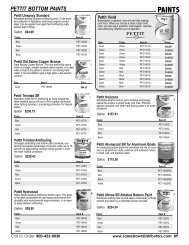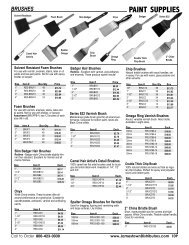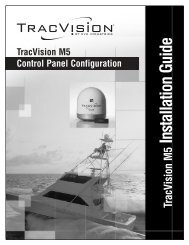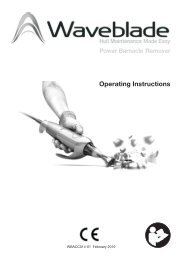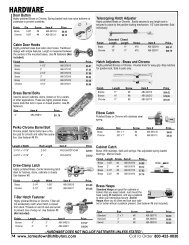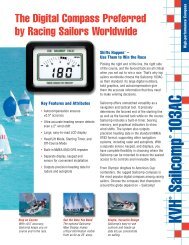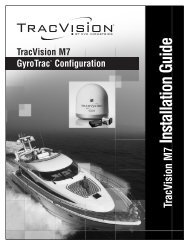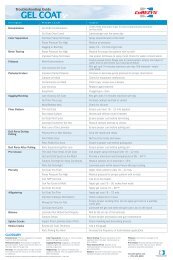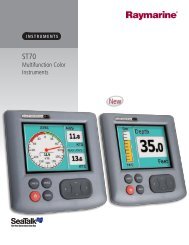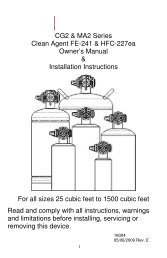StarBrite Mildew Stain Remover MSDS - Jamestown Distributors
StarBrite Mildew Stain Remover MSDS - Jamestown Distributors
StarBrite Mildew Stain Remover MSDS - Jamestown Distributors
You also want an ePaper? Increase the reach of your titles
YUMPU automatically turns print PDFs into web optimized ePapers that Google loves.
MATERIAL SAFETY DATA SHEET<br />
SECTION 1 - PRODUCT AND COMPANY IDENTIFICATION<br />
PRODUCT NAME: <strong>Mildew</strong> <strong>Stain</strong> <strong>Remover</strong><br />
PART NUMBER: 85616<br />
GENERAL USE: Cleaning agent<br />
PRODUCT DESCRIPTION: Clear liquid, mild lemon odor<br />
MANUFACTURER'S NAME<br />
DATE PREPARED: April 19, 2006<br />
Star brite Distributing, Inc.<br />
SUPERSEDES: July 23, 2005<br />
Page 1 of 4<br />
ADDRESS (NUMBER, STREET, P.O. BOX)<br />
TELEPHONE NUMBER FOR INFORMATION<br />
4041 S. W. 47 Avenue (954) 587-6280<br />
(CITY, STATE AND ZIP CODE)<br />
COUNTRY EMERGENCY TELEPHONE NUMBER<br />
Ft. Lauderdale, FL 33314<br />
USA Chemtrec (800) 424-9300 Outside USA (703) 527-3887<br />
DISTRIBUTOR'S NAME<br />
Same<br />
ADDRESS (NUMBER, STREET, P.O. BOX)<br />
TELEPHONE NUMBER FOR INFORMATION<br />
(CITY, STATE AND ZIP CODE)<br />
COUNTRY<br />
EMERGENCY TELEPHONE NUMBER<br />
HAZARDOUS COMPONENTS<br />
Sodium hypochlorite ( a)<br />
SECTION 2 - HAZARDOUS INGREDIENTS<br />
%<br />
(by weight)<br />
CAS #<br />
EINECS #<br />
10 - 30 7681-52-9 231-668-3 C<br />
Hazard<br />
Symbol<br />
RISK PHRASES<br />
Full Text Section 16<br />
R-31, 34<br />
(a) See Section 15<br />
SECTION 3 - HAZARDS IDENTIFICATION<br />
EMERGENCY OVERVIEW<br />
Corrosive. Causes chemical burns to skin and eyes. Hazard Symbols for this product: C, Risk Phrases - R31, 34<br />
POTENTIAL HEALTH EFFECTS<br />
INHALATION: Corrosive and irritating to upper respiratory tract and mucous membranes. May cause severe irritation and sneezing.<br />
Prolonged or repeated overexposure by inhalation may cause pneumonia, lung damage, damage to respiratory system, even death.<br />
SKIN: Corrosive; chemical burns may result from contact. Repeated or prolonged skin contact may cause skin damage.<br />
EYES: CORROSIVE; Contact with eyes is painful and irritating and will cause chemical burns, eye damage, blindness.<br />
INGESTION: Corrosive and irritating to digestive tract; may cause severe irritation, tissue ulceration, gastrointestinal damage, circulatory<br />
collapse, convulsions, coma, even death.<br />
CARCINOGENICITY NTP? No IARC MONOGRAPHS? No OSHA REGULATED? No
MATERIAL SAFETY DATA SHEET<br />
PRODUCT NAME: <strong>Mildew</strong> <strong>Stain</strong> <strong>Remover</strong><br />
April 19, 2006<br />
SECTION 4 - FIRST AID MEASURES<br />
INHALATION: Remove affected person to fresh air; if not breathing give artificial respiration; if victim is conscious and alert, wash mouth and<br />
nasal passages with water repeatedly; if breathing is difficult give oxygen; seek medical attention.<br />
SKIN: Wash contacted area with plenty of water while removing contaminated clothing and shoes; DO NOT attempt to neutralize with chemical<br />
agents; seek medical attention.<br />
EYES: Check for and remove contact lenses. Immediately flush eyes for 15 minutes in clear running water while holding eyelids open; seek<br />
medical attention immediately.<br />
INGESTION: Rinse mouth with water; drink large quantities of water; DO NOT induce vomiting; never give anything by mouth to an<br />
unconscious person; if vomiting occurs spontaneously, keep head below hips to prevent aspirating vomitus into lungs; seek medical attention<br />
immediately.<br />
SECTION 5 - FIRE FIGHTING MEASURES<br />
FIRE FIGHTING PROCEDURES<br />
Prevent human exposure to fire, fumes, smoke, and products of combustion. Evacuate non essential personnel. Firefighters should wear full<br />
face, self contained breathing apparatus and impervious protective clothing.<br />
UNUSUAL FIRE AND EXPLOSION HAZARDS<br />
Product does not burn, but can provide oxygen which can intensify a fire. Toxic fumes may be released. Product is an oxidizer. It may react<br />
vigorously with organics or other materials resulting in an explosion and fire.<br />
HAZARDOUS COMBUSTION PRODUCTS<br />
Smoke, fumes or vapors, oxides of carbon.<br />
SECTION 6 - ACCIDENTAL RELEASE MEASURES<br />
SECTION 7 - HANDLING AND STORAGE<br />
PRECAUTIONS TO BE TAKEN IN HANDLING AND STORAGE: Keep container closed when not in use; Store in a cool dry place. Store out<br />
of direct sunlight and away from heat. Separate from oxidizing materials, metallic powders and other easily oxidized organic materials and<br />
reducing agents. Product is an oxidizer and may react vigorously with organic or other materials resulting in an explosion and fire. CAUTION -<br />
material is corrosive. Keep this and other chemicals out of reach of children.<br />
SECTION 8 - EXPOSURE CONTROLS / PERSONAL PROTECTION<br />
Page 2 of 4<br />
GENERAL HAZARDS: Product is corrosive. Products of combustion include compounds of carbon, hydrogen, chlorine and oxygen, including<br />
carbon monoxide.<br />
EXTINGUISHING MEDIA<br />
Water, water fog<br />
STEPS TO BE TAKEN IN CASE MATERIAL IS RELEASED OR SPILLED: CAUTION - CORROSIVE. Product may be toxic to fish or aquatic<br />
life. Evacuate non essential personnel, eliminate ignition sources, and wear protective equipment. (See Section 3). Shut off source of leak<br />
only if safe to do so. Contain spill. Recover free product. To clean up residue, add reducing agents such as bisulfites or ferrous salt solutions.<br />
Some heat will be produced. Maintain pH on alkaline side (> 7.5) and dilute with large quantities of water. For spills in excess of allowable<br />
limits refer to CERCLA 40 CFR 302 for detailed instructions.<br />
HAZARDOUS COMPONENTS<br />
Sodium hypochlorite ( a)<br />
NIOSH<br />
ACGIH<br />
TWA ppm TWA mg/m3 STEL ppm STEL mg/m3 TWA ppm TWA mg/m3 STEL ppm STEL mg/m3<br />
1 1<br />
PERSONAL PROTECTION:<br />
RESPIRATORY PROTECTION: If exposure limits are exceeded, or if exposure may occur, use a NIOSH/MSHA respirator approved for your<br />
conditions of exposure. Refer to the most recent NIOSH publications concerning chemical compliance with OSHA requirements in 29 CFR<br />
1910.134 or European Standard EN 149 for complete regulations.. For emergencies, a NIOSH/MSHA approved positive pressure breathing<br />
PROTECTIVE GLOVES: Neoprene, butyl or nitrile rubber gloves with cuffs.<br />
EYE PROTECTION: Chemical goggles with face shield Refer to 29 CFR 1910.133 or European Standard EN166.<br />
OTHER PROTECTIVE CLOTHING OR EQUIPMENT: Coveralls, apron, or other equipment worn to prevent skin contact, safety eyewash<br />
station nearby.<br />
WORK / HYGIENIC PRACTICES: Practice safe workplace habits. Minimize body contact with this, as well as all chemicals in general.
MATERIAL SAFETY DATA SHEET<br />
PRODUCT NAME: <strong>Mildew</strong> <strong>Stain</strong> <strong>Remover</strong><br />
April 19, 2006<br />
SECTION 9 - PHYSICAL AND CHEMICAL PROPERTIES<br />
APPEARANCE AND ODOR<br />
VAPOR PRESSURE<br />
Clear liquid, mild lemon odor<br />
17 mm Hg @ 20° C<br />
pH SPECIFIC GRAVITY (WATER = 1)<br />
10.0 - 11.0<br />
1.0 - 1.1<br />
BOILING POINT / BOILING RANGE<br />
SOLUBILITY IN WATER<br />
232° F (111° C)<br />
Complete<br />
FLASH POINT<br />
VISCOSITY<br />
Non-flammable<br />
Like that of water<br />
FLAMMABLE LIMITS VAPOR DENSITY (AIR = 1)<br />
LEL: Not applicable UEL: Not applicable > 1<br />
AUTOIGNITION TEMPERATURE<br />
EVAPORATION RATE (WATER = 1)<br />
Not determined < 1<br />
SECTION 10 - STABILITY AND REACTIVITY<br />
Page 3 of 4<br />
STABILITY<br />
UNSTABLE:<br />
CONDITIONS TO AVOID: Amphoteric metals, inorganic acids, organic<br />
STABLE: XXX acids, organic bases, hydrocarbons, organic mixtures.<br />
INCOMPATIBILITY (MATERIALS TO AVOID): Amphoteric metals, aluminum, copper, zinc, and brass; strong reducing agents, hydrogen,<br />
hydrazine, sulfides, sulfites, and nitrites.<br />
HAZARDOUS DECOMPOSITION OR BYPRODUCTS: Decomposition will not occur if handled and stored properly. In case of a fire, chlorine,<br />
oxides of carbon, hydrocarbons, fumes or vapors, and smoke may be produced.<br />
HAZARDOUS POLYMERIZATION MAY OCCUR:<br />
CONDITIONS TO AVOID: None<br />
WILL NOT OCCUR: XXX<br />
Sodium hypochlorite ( a)<br />
Hazardous Components<br />
SECTION 11 - TOXICOLOGICAL INFORMATION<br />
CAS #<br />
EINECS #<br />
7681-52-9<br />
231-668-3<br />
LD50 of Ingredient<br />
(Specify Species and Route)<br />
> 8190 mg / kg<br />
Oral - rat<br />
LC50 of Ingredient<br />
(Specify Species)<br />
293 / ppm / 1H<br />
Inhalation - rat<br />
(a) See Section 15<br />
SECTION 12 - ECOLOGICAL INFORMATION<br />
No data are available on the adverse effects of this material on the environment. Neither COD nor BOD data are available. Based on the<br />
chemical composition of this product it is assumed that the mixture can be treated in an acclimatized biological waste treatment plant system in<br />
limited quantities. However, such treatment should be evaluated and approved for each specific biological system. None of the ingredients in<br />
this mixture are classified as a Marine Pollutant.<br />
SECTION 13 - DISPOSAL CONSIDERATIONS<br />
WASTE DISPOSAL METHOD: Solids must be disposed of in a permitted waste management facility. Recovered liquids may be reprocessed<br />
or incinerated in a permitted facility capable of handling chlorine-containing compounds. Dispose of in accordance with Local, State, and<br />
Federal Regulations. Refer to "40 CFR Protection of Environment Parts 260 - 299" for complete waste disposal regulations for corrosive<br />
materials. Consult your local, state, or Federal Environmental Protection Agency before disposing of any chemicals. According to the<br />
European Waste Catalogue, waste codes are application specific and should be assigned by the user based on the application for which the<br />
product is used.<br />
SECTION 14 - TRANSPORT INFORMATION<br />
PROPER SHIPPING NAME: Hypochlorite solution (< 15%)<br />
DOT HAZARD CLASS / Pack Group: 8 / III<br />
IATA HAZARD CLASS / Pack Group: 8 / III<br />
REFERENCE: 49 CFR 173.154, .203, .241<br />
IMDG HAZARD CLASS: 8 / III<br />
UN / NA IDENTIFICATION NUMBER:<br />
LABEL:<br />
UN1791<br />
Consumer Commodity ORM-D<br />
RID/ADR Dangerous Goods Code: 8<br />
UN TDG Class / Pack Group: 8 / III<br />
Hazard Identification Number (HIN): 80<br />
Note: Transportation information provided is for reference only. Client is urged to consult CFR 49 parts 100 - 177, IMDG, IATA, EU, United<br />
Nations TDG, and WHMIS (Canada) TDG information manuals for detailed regulations and exceptions covering specific container sizes,<br />
packaging materials and methods of shipping.
MATERIAL SAFETY DATA SHEET<br />
PRODUCT NAME: <strong>Mildew</strong> <strong>Stain</strong> <strong>Remover</strong><br />
April 19, 2006<br />
SECTION 15 - REGULATORY INFORMATION<br />
TSCA (USA - Toxic Substance Control Act)<br />
All components of this product are listed on the U.S. Toxic Substances Control Act Chemical Inventory (TSCA Inventory) or are exempted<br />
from listing because a Low Volume Exemption has been granted in accordance with 40 CFR 723.50.<br />
SARA TITLE III (USA - Superfund Amendments and Reauthorization Act)<br />
311/312 Hazard Categories<br />
Immediate health<br />
Page 4 of 4<br />
313 Reportable Ingredients:<br />
None<br />
CERCLA (USA - Comprehensive Response Compensation and Liability Act)<br />
(a) The Comprehensive Environmental Response, Compensation, and Liability Act (CERCLA) has notification requirements for releases or<br />
spills to the environment of the Reportable Quantity (RQ for this mixture = 100 lbs) or greater amounts, according to 40 CFR 302.<br />
California Prop 65, Safe Drinking Water and Toxic Enforcement Act of 1986<br />
There are no chemicals present known to the state of California to cause cancer or reproductive toxicity.<br />
CPR (Canadian Controlled Products Regulations)<br />
This product has been classified in accordance with the hazard criteria of the Controlled Products Regulations and the <strong>MSDS</strong> contains all the<br />
information required by the Controlled Products Regulations. WHMIS Classification: E<br />
IDL (Canadian Ingredient Disclosure List)<br />
Components of this product identified by CAS number and listed on the Canadian Ingredient Disclosure List are shown in Section 2.<br />
DSL / NDSL (Canadian Domestic Substances List / Non-Domestic Substances List)<br />
Components of this product identified by CAS number are listed on the DSL or NDSL, or are otherwise in compliance with the New<br />
Substances Notification (NSN) regulations. Only ingredients classified as "hazardous" are listed in Section 2 unless otherwise indicated.<br />
EINECS (European Inventory of Existing Commercial Chemical Substances)<br />
Components of this product identified by CAS numbers are on the European Inventory of Existing Commercial Chemical Substances.<br />
WGK Water Quality Index: 2<br />
VbK Index: Not applicable<br />
RISK PHRASES:<br />
R31 Contact with acids liberates toxic gas.<br />
R34 Causes burns.<br />
Notes & full R-Phrase text<br />
SYMBOL(S) REQUIRED FOR<br />
LABEL<br />
Corrosive<br />
SECTION 16 - OTHER INFORMATION<br />
R31 Contact with acids liberates toxic gas.<br />
R34 Causes burns.<br />
SAFETY PHRASES:<br />
S26 In case of contact with eyes, rinse immediately with<br />
plenty of water and seek medical advice.<br />
S36/37/39 Wear suitable protective clothing, gloves and<br />
eye/face protection.<br />
S45 In case of accident or if you feel unwell, seek medical<br />
advice immediately (show the label whenever possible.)<br />
HMIS HAZARD RATINGS<br />
HEALTH<br />
2 * = Chronic Health Hazard 2 = MODERATE<br />
FLAMMABILITY<br />
0 0 = INSIGNIFICANT<br />
3 = HIGH<br />
PHYSICAL HAZARD 0 1 = SLIGHT 4 = EXTREME<br />
PERSONAL PROTECTIVE EQUIPMENT<br />
C<br />
Safety Glasses, Gloves, Apron<br />
The information contained herein is believed to be accurate but is not warranted to be so. Data and calculations are based on information furnished by the<br />
manufacturer of the product and manufacturers of the components of the product. Users are advised to confirm in advance of need that information is current,<br />
applicable and suited to the circumstances of use. Vendor assumes no responsibility for injury to vendee or third persons proximately caused by the material if<br />
reasonable safety procedures are not adhered to as stipulated in the data sheet. Furthermore, vendor assumes no responsibility for injury caused by abnormal use of<br />
this material even if reasonable safety procedures are followed. Any questions regarding this product should be directed to the manufacturer of the product as<br />
described in Section 1.



